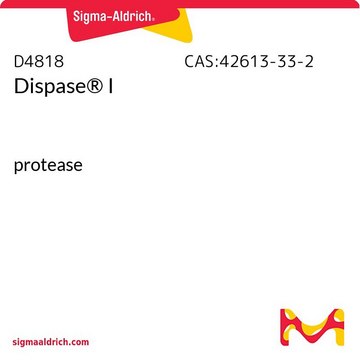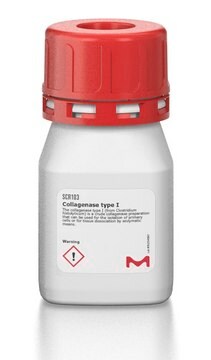Wichtige Dokumente
B20223
Collagenase - DNase I - Dispase II blend
Tissue dissociation blend, lyophilized powder, suitable for cell culture
Synonym(e):
Clostridiopeptidase A, Clostridium histolyticum, DNase I, Deoxyribonuclease I, Deoxyribonucleate 5′-oligonucleotido-hydrolase, Dispase II, Protease from Bacillus polymyxa, collagenase, collagenase blend, enzyme blend, tissue dissociation blend
About This Item
Empfohlene Produkte
Qualitätsniveau
Form
lyophilized powder
Spezifische Aktivität
≥2 units/mL Dispase II
Konzentration
0.1 mg/mL (DNase)
1 mg/mL (collagenase)
Methode(n)
cell culture | mammalian: suitable
Versandbedingung
dry ice
Lagertemp.
-10 to -25°C
Allgemeine Beschreibung
Biochem./physiol. Wirkung
Angaben zur Herstellung
Signalwort
Danger
H-Sätze
Gefahreneinstufungen
Eye Irrit. 2 - Resp. Sens. 1 - Skin Irrit. 2 - STOT SE 3
Zielorgane
Respiratory system
Lagerklassenschlüssel
11 - Combustible Solids
WGK
WGK 3
Analysenzertifikate (COA)
Suchen Sie nach Analysenzertifikate (COA), indem Sie die Lot-/Chargennummer des Produkts eingeben. Lot- und Chargennummern sind auf dem Produktetikett hinter den Wörtern ‘Lot’ oder ‘Batch’ (Lot oder Charge) zu finden.
Besitzen Sie dieses Produkt bereits?
In der Dokumentenbibliothek finden Sie die Dokumentation zu den Produkten, die Sie kürzlich erworben haben.
Unser Team von Wissenschaftlern verfügt über Erfahrung in allen Forschungsbereichen einschließlich Life Science, Materialwissenschaften, chemischer Synthese, Chromatographie, Analytik und vielen mehr..
Setzen Sie sich mit dem technischen Dienst in Verbindung.










